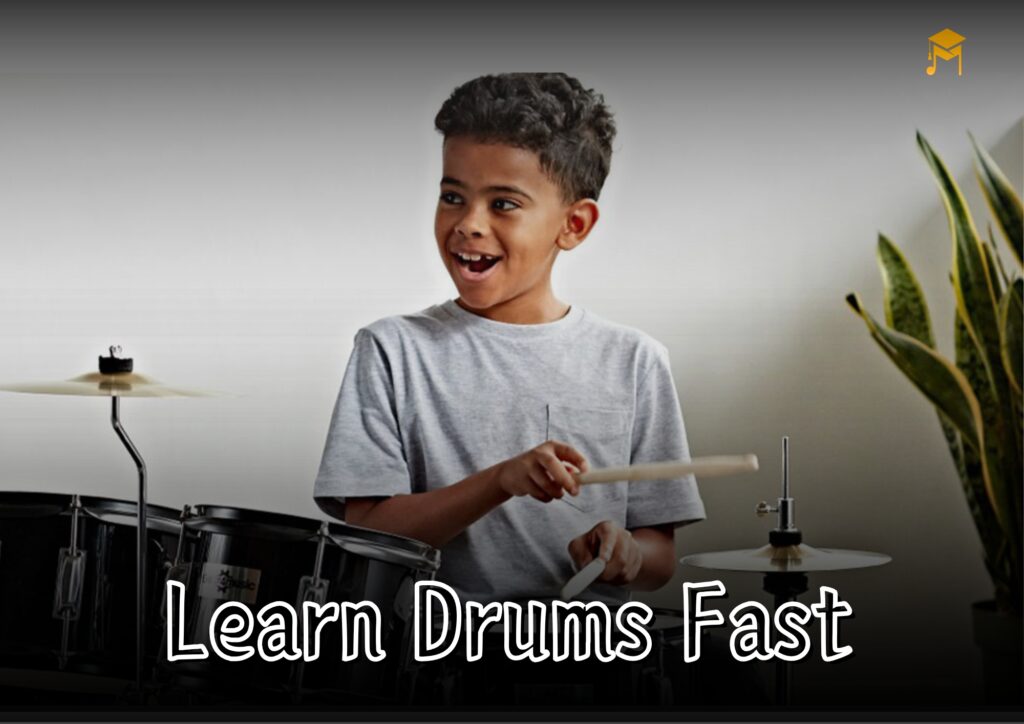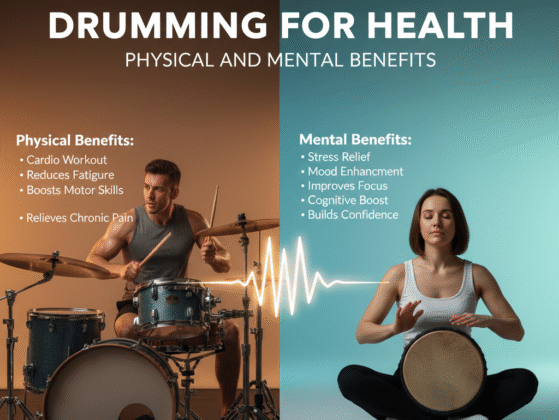How to Learn Drums Fast ?
Learning to play the drums is a rewarding and exhilarating experience, but for many beginners, the process can seem daunting. With so many elements to master—from rhythm to technique—it’s easy to feel overwhelmed. However, if you’re looking to learn drums fast, the right approach and mindset can help you fast-track your drumming skills and become proficient in a shorter time than you might expect.
In this blog, we’ll explore proven strategies to help you learn drums faster, focusing on everything from practice techniques to mindset shifts, along with some bonus tips for efficient learning.
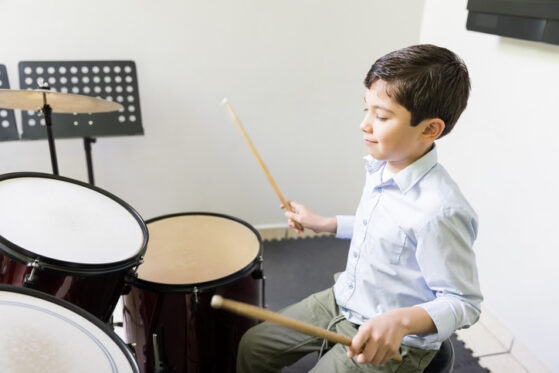
Start with the Basics | Understanding Rhythm and Timing
Before diving into playing complex patterns, it’s crucial to develop a solid foundation in rhythm and timing. As drums are the backbone of most musical compositions, your ability to keep steady time is essential. Here’s how to quickly get comfortable with rhythm:
- Use a metronome: This device helps you maintain a consistent tempo. Practice playing basic beats and rudiments at different speeds, focusing on staying in time.
- Clap or tap along to songs: One of the simplest ways to internalize rhythm is to clap or tap along to music. Start with slower songs and move to faster ones as you get better.
- Count out loud: Counting out loud (1-2-3-4) while you play helps you stay connected to the rhythm. This practice reinforces your timing and keeps you on track.
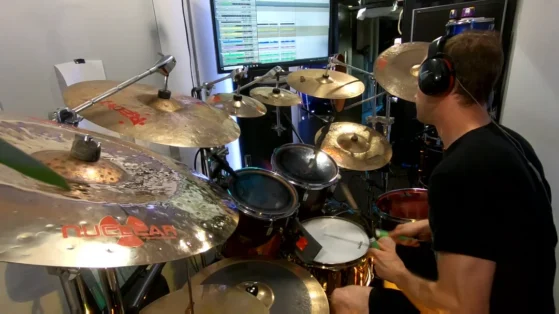
Learn Drum Rudiments Early On
Drum rudiments are the building blocks of all drumming techniques. They consist of simple patterns that, when mastered, can be combined into more complex beats. By learning rudiments, you’ll improve your speed, control, and coordination on the drums.
Some essential rudiments to focus on are:
- Single Stroke Roll (alternating hands)
- Double Stroke Roll (two hits per hand)
- Paradiddle (alternating strokes: RLRR LRLL)
Practice these rudiments daily at varying tempos. Start slowly to ensure accuracy, then gradually increase the speed as you gain control. The key here is consistency. Mastering these rudiments will greatly enhance your overall drumming abilities and help you play faster and more fluidly.

Develop Hand and Foot Coordination
One of the biggest challenges for new drummers is coordinating their hands and feet. Drumming is a full-body experience, requiring precise coordination between all limbs. Here are a few tips to improve limb independence and speed up your learning:
- Practice hands and feet separately: Before combining hand and foot patterns, spend time practicing them individually. For example, play a basic kick drum beat (foot) without using your hands, then add snare hits (hands) once you’re comfortable.
- Start with simple beats: Focus on simple 4/4 time beats like the basic rock beat (kick on 1 and 3, snare on 2 and 4) before moving on to more complex patterns. Once you master simpler beats, you’ll be able to layer more intricate rhythms.
- Use exercises to improve independence: Drummers often struggle with playing different rhythms with their hands and feet simultaneously. To overcome this, try exercises that focus on limb independence, such as playing eighth notes on the hi-hat with one hand while maintaining a steady kick-snare pattern.
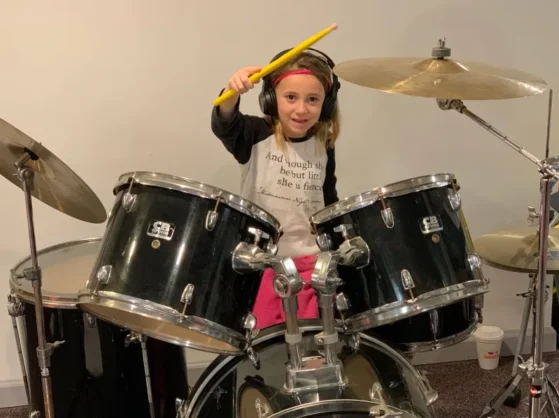
Practice with Purpose
Effective practice is key to learning the drums quickly. Rather than sitting behind the kit and randomly hitting the drums, structure your practice sessions for maximum productivity:
- Set clear goals: Identify specific skills you want to improve during each practice session. For example, one session might focus on improving your double stroke roll, while another is dedicated to learning a specific song or beat.
- Use a practice routine: Create a routine that balances rudiments, coordination exercises, and playing along with songs. Allocate time for each area of practice to ensure balanced skill development.
- Keep sessions short but consistent: Instead of marathon practice sessions, aim for shorter, focused sessions every day. Consistency is key—daily practice, even for 20-30 minutes, yields better results than sporadic long sessions.

Play Along with Music
One of the best ways to speed up your learning process is to play along with your favorite songs. Not only is it more enjoyable, but it also helps you develop your listening skills, timing, and groove. Here’s how to make the most of playing along with music:
- Choose beginner-friendly songs: Start with slow to mid-tempo songs with simple drum parts. As you gain confidence, challenge yourself with more complex tracks.
- Use drumless tracks: Many platforms offer drumless backing tracks, allowing you to play along and fill in the drum parts. This exercise can enhance your creativity and make you feel like you’re playing in a band.
- Record yourself: Listening back to recordings of your drumming will reveal areas where you need improvement, such as timing, dynamics, or feel. Recording your progress also helps you stay motivated as you notice improvements over time.

Focus on Technique
While it may be tempting to learn drums fast and play as quickly as possible, focusing on technique early on will save you time in the long run. Proper technique helps you play efficiently, prevents injury, and allows for smoother progression. Some key points to focus on include:
- Proper grip: Ensure you’re holding the drumsticks correctly—neither too tight nor too loose. A good grip provides control without sacrificing speed.
- Relaxed playing: Tension in your hands, arms, or body will slow you down and lead to fatigue. Focus on staying relaxed while playing, even during fast or intense parts.
- Good posture: Sit comfortably and maintain good posture behind the kit to avoid strain or injury during longer practice sessions.

Learn to Read Drum Notation
Understanding drum notation is like learning the language of drumming. It enables you to quickly learn new beats, fills, and songs without needing to rely on videos or audio tutorials. Learning to read drum notation early on will speed up your learning process and give you access to a wider range of drumming resources.
- Start with basic sheet music: Focus on learning the basics of drum notation, such as note values (eighth notes, quarter notes, etc.) and common drum symbols (kick, snare, hi-hat).
- Use drum notation apps: There are numerous apps that can help you read drum music while playing along, making the learning process more interactive and fun.

Take Online Drum Lessons
If you’re serious about learning drums quickly, consider investing in online drum lessons. There are numerous platforms that offer structured courses with professional instructors. Online lessons allow you to:
- Learn from experts: Many online platforms feature lessons from world-class drummers, giving you access to expert advice and instruction from anywhere in the world.
- Progress at your own pace: Online courses allow you to work through material at a speed that suits you, giving you the flexibility to focus on areas where you need more practice.
- Access a variety of lessons: You can find lessons on everything from rudiments to advanced techniques, allowing you to tailor your learning to your goals.

Stay Motivated and Have Fun
Learning the drums can be challenging, especially when you’re aiming to learn drums fast. It’s important to stay motivated and enjoy the process. Celebrate small victories along the way—whether it’s mastering a new rudiment or playing your first song. Keep a positive mindset, and remember that learning an instrument is a journey.
- Set mini-goals: Break down your long-term drumming goals into smaller, manageable tasks. Accomplishing these mini-goals will keep you motivated.
- Jam with others: Playing music with other musicians can enhance your skills and is a great way to stay inspired. Whether it’s joining a band or simply jamming with friends, collaboration helps you improve your musicality and timing.
- Take breaks: While consistent practice is essential, don’t forget to take breaks to avoid burnout. Step away from the drums when you need to recharge your energy and come back with renewed focus.

Bonus Tips for Fast Drumming Progress
- Use a drum pad: A drum practice pad allows you to work on your technique without needing a full drum kit. It’s perfect for practicing rudiments, sticking, and improving your hand speed anywhere, anytime.
- Watch drumming tutorials: YouTube and other platforms offer a wealth of drumming tutorials for players of all levels. These free resources can help you learn new techniques, beats, and fills.
- Track your progress: Keep a practice journal to document your progress. Record what you practiced, any challenges you faced, and the improvements you noticed. Tracking your journey will provide a sense of accomplishment and show how far you’ve come.

Conclusion
While learning the drums takes time and dedication, applying the right strategies will significantly speed up the process. By focusing on rhythm, technique, and purposeful practice, you can learn drums fast and see noticeable improvement in a shorter amount of time. For those looking for structured guidance, learn drums lessons online with The Mystic Keys. Whether you’re a complete beginner or an intermediate player looking to improve, following these tips will help you progress quickly while enjoying the process. Keep practicing, stay motivated, and most importantly—have fun!


